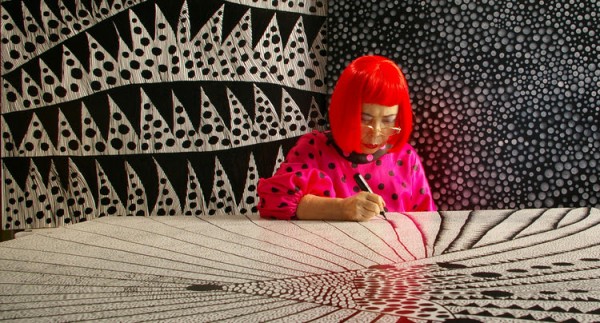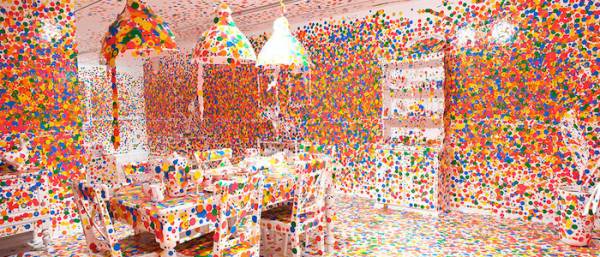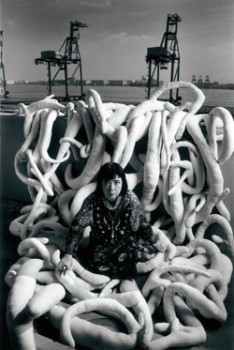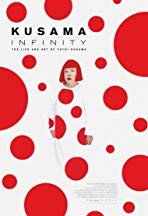YAYOI KUSAMA: WHY HAD I NEVER HEARD OF HER? YAYOI KUSAMA TODAY, WORKING ON A PAINTINGDelayed recognition?Kusuma: Infinity
YAYOI KUSAMA TODAY, WORKING ON A PAINTINGDelayed recognition?Kusuma: Infinity is the modest title of this little documentary. Why had I never heard of her? She's the most famous and most popular female artist in the world, now. (Who was before?) She's a rock star. Her name is Yayoi Kusama, and she comes from a little town in Japan, Matsumoto, in Nagano Prefecture. Her entire life was an enormous struggle but she was enormously ambitious and productive and, well, pushy. And crazy too - that's part of the struggle, because she has suffered from depression and now, for some time, has been living in a Tokyo psychiatric hospital, as she has for over forty years, but working in a big studio in the daytime. Back in Matsumoto, which rejected her as too radical, while she rejected it as too provincial, she is now accepted as the big local art treasure. In Tokyo, there is a museum devoted to her. But is having major recognition elsewhere too. Major retrospectives of her work have been presented at Tate Modern in London (2012) and the Hirshhorn Museum in Washington (2017).
Artistic fame is a funny thing. And when it becomes massive, it ceases to be a critical asset and becomes more of a liability. The thousands waiting around the block to see Kusama's shows today, like the crowds lining up to look at shows by Andrew Wyeth (depicted in
an admiring documentary I reviewed last week), whose immense popularity only makes the artistically discerning more suspicious than they were already. Kusama is, of course, remote in style from Wyeth. Unlike him, she fulfills Irish design master Eileen Gray's requirement that an artist must only be of her own time. She is of her time, very much so. When things subside we can look back and see if she seems to have been a master. Right now, she seems like a messier, more childlike kind of Anish Kapoor. There seems little depth in her work. She makes Wyeth's seem profound, personal, and evocative. Still, she is of her time. But this little documentary provides too limited a picture of her complicated life and immense productivity, and too little critical analysis of her work.
Now, no doubt, whether it matters to her, she is probably making a lot of money. (Articles show that in recent years at auction she has repeatedly been one of the top ten most expensive female artists.) But at the end of her work day, she still returns to the psychiatric hospital, down the street. And by the way, she is ferocious looking, wears a red wig and bright clothing, and is 89 years old. She is still productive, and given her fame and continuing energy and the means of production now at her disposal, productive on a jaw-dropping scale. Whether she is slowing down any we aren't told. But her isolated life and odd habitation must contribute to her intense focus on the obsessive work. The film shows huge museum rooms packed with equal-sized bright-colored paintings she has recently done.They are brighter and more cheerful than her early work. (There is not much attempt to account for the variety of media in which she has worked.)
The production began, and also the struggle, when she was five or six years old. She relentlessly produced drawings. But her mean mother would sneak up behind her and grab the drawings, and throw them in the trash. This is not what you would call encouraging a child's creative instincts to be unleashed. Her mother also forced her to spy on her father with his long string of mistresses, which gave her a horror of phallic images and a distaste for sex, but an impulse for voyeurism, while over-all drawings and paintings, the dots around and upon her and covering everything in a room, are a conscious effort at self-obliteration. Her distinctive current "look" can also be seen as an effort to vanish into her work, though the film doesn't say that.
 Kusama participatory installation "Obliteration Room," with dots attached by thousands of museum visitors, Tate Modern, 2012. MAKING OF.
Kusama participatory installation "Obliteration Room," with dots attached by thousands of museum visitors, Tate Modern, 2012. MAKING OF.This film hits all the high spots. But it seems to skip rapidly over some of the important details of Kusama's early life, perhaps rightly, if somewhat misleadingly, concentrating on her important first period in New York. What we do learn is that her parents were important producers of flower seeds, and plants became a nightmare image for her, but also perhaps an inspiration. (In Kusama's world, nightmares and inspirations aren't far apart anyway.) Early work was black and white, line drawings of many circles, imagery that later turned into three-dimensional installations, sometimes including electric lights and mirrors, of imaginary galaxies staged in the walls or a large gallery. These grew out of hallucinations of worlds of scintillating dots. She grew up in the war, and even worked in a factory making parachutes. Later, in 1948, she attended the Kyoto Municipal School of Arts and Crafts, but she resonated more already with the European avant-garde. After living in Tokyo and France, Kusama left Japan at the age of 27 for the United States, Wikipedia tells us. This film skips over the fact that she earned considerable réclame in Japan before going to live in the US. Before departing, she lightened her luggage by destroying a thousand or two of her works.
Heather Lenz makes much of a letter the young Kusama wrote (sending two watercolors) - we even hear the words - to Georgia O'Keefe. O'Keefe wrote back encouraging her to come to America. She did. I don't recall mention that in 1957 she stopped over in Seattle for a year and had her first American solo show at Dusanne Gallery there. In New York, she plunged into the art scene, but being Japanese and a woman was detrimental. So was the fact that it was the height of the abstract expressionist movement, and her work was a kind of obsessive-decorative abstraction, naively executed, like elaborate doodles, without a sense of artistic combat with tradition or any record of the creative process such as one found in Kline, De Kooning, Pollack, even Rothko. (Her paintings also lacked the zen transcendence of Agnes Martin.)
She did large works, monochromatic paintings of circles and constellations. She pushed and pushed, trying to get into the most important galleries. She was able to show her work at the artist-run Brata Gallery. She met Donald Judd (and also Eva Hesse, Wikipedia says: but does the film mention this important friendship?); they lived in the same building. According to Heather Lenz's documentary, Kusama's shimmering gallery installations covering the walls made at this time were an idea immediately copied by both Andy Warhol and Claes Oldenburg.
Joseph Cornell was in love with the young Kusama. The fact that both were uninterested in sex helped them form a bond. But Cornell lived with his mother, whom he loved more and favored over his girlfriend, so she pulled away, though he clung to her and wrote constant letters for a long time. Details of this relationship are left sketchy but a useful online timeline,
YAYOI KUSAMA: LOOK NOW, SEE FOREVER clarifies that "the death of her partner, Joseph Cornell" in 1973, led her to return to Japan, and by 1975 she was living there continually. In 1975 she was "hospitalized at Seiwa Hospital in Tokyo’s Shinjuku district," and two years later became a permanent resident there.
Earlier, she had forced her way into the 1966 Venice Biennale, selling her silver plastic balls on the lawn for a couple of dollars, which was doubly frowned upon by the festival organizers - for gate-crashing and for selling her art like popsicles. Much later, in 1993 she returned as the single artist featured in the Japan pavilion, a triumphant reversal.
In the early New York days, Frank Stella liked her "Yellow Net" painting in the Stephen Radich Gallery, a big monochromatic, linear work, typical of what she did then, that was black and yellow. The yellow reminded him of New York taxis. He found her asking price, $75, a bit expensive, but he managed to buy the painting in three installments, he says here. It has since sold, we're told, for $750,000. She was overworked, and regularly hospitalized for exhaustion, the timeline says. And she was economically strapped: Georgia O'Keefe, who remained a friend, tried to save her from poverty by having her own gallery buy several of Kusama's works. This detail also is from the timeline, not Lenz's film.
 Portrait of Yayoi Kusama at Tokyo Bay, 1993 /
Portrait of Yayoi Kusama at Tokyo Bay, 1993 /
Photograph: Yuichi Hiruta / Image courtesy: Ota Fine
Arts, Tokyo / © Yayoi Kusama, Yayoi Kusama Studio inc.Kusama was part of the Sixties scene, and we see numerous quick cuts from films of nude "happenings" she staged, putatively immune to their sexiness, of nude men and women whom she painted with her circles and blobs. She was included in the 1961 Whitney Biennial (the timeline again). Despite or because of all this activity, she became depressed with it, and her return to Japan somehow seems unsurprising. In the Eighties, she wrote poems and novels, and made three dimensional works as well as increasingly spectacular - and beautiful - installations. It is probably these large, visually enjoyable productions, along with contemporary museums' increasingly intense efforts at production and promotion of exhibitions to pay increasingly high costs of these efforts, that help explain Kusama's growing popularity as an international art figure. From the time-line for 1993: "In July, Kusama collaborates with British musician Peter Gabriel on an installation in Yokohama." By then, nut case or no - but didn't that contribute to the exotic image she projects, along with her colorful outfits? - she was a pop star. And now, the film shows that her paintings have long moved from monochromatic to bright, cheerful colors, seemingly chosen and arranged in circular shapes at random. She never plans, and never stops working. That was true of Picasso. But on the other hand, Picasso had an immense influence on modern art, and Kusama didn't. Her success somehow has not led to her being a household word or to her images having a signature like the great abstract expressionists', Frank Stella's, her neighbor Donald Judd's. . . one could go on. But now - a Tate Modern spokesperson says, she has become a "major brand." Like toothpaste. Or Jeff Koons. Soulless, but unmistakable.
Given the complexity of Kusama's life, and its immense contradictions, the way it combines neurosis and suffering with constant productivity and worldwide fame (which nonetheless my ignorance shows, is not universal), one can understand that Heather Lenz might have trouble providing a coherent and thorough picture of this artist, let alone an evaluation of her value to the art world. Hardly any critical assessments are cited amid the breathless - but patchy - account of her career. The film mentions that one reason Cornell and Kusama got along was their opacity about their inner lives. That carries over into this little documentary, which despite Kusama's evident cooperation, plays more like a promo piece than a definitive study.
Kusama: Infinity, 80 mins., Heather Lenz's first feature, debuted at Sundance Jan. 2018. It also showed at Cleveland. Its US theatrical release is set for 7 Sept. 2018. It opens at the Landmark Embarcadero, San Francisco and the Landmark Shattuck, Berkeley on 14 Sept.
 FILM POSTER
FILM POSTER





